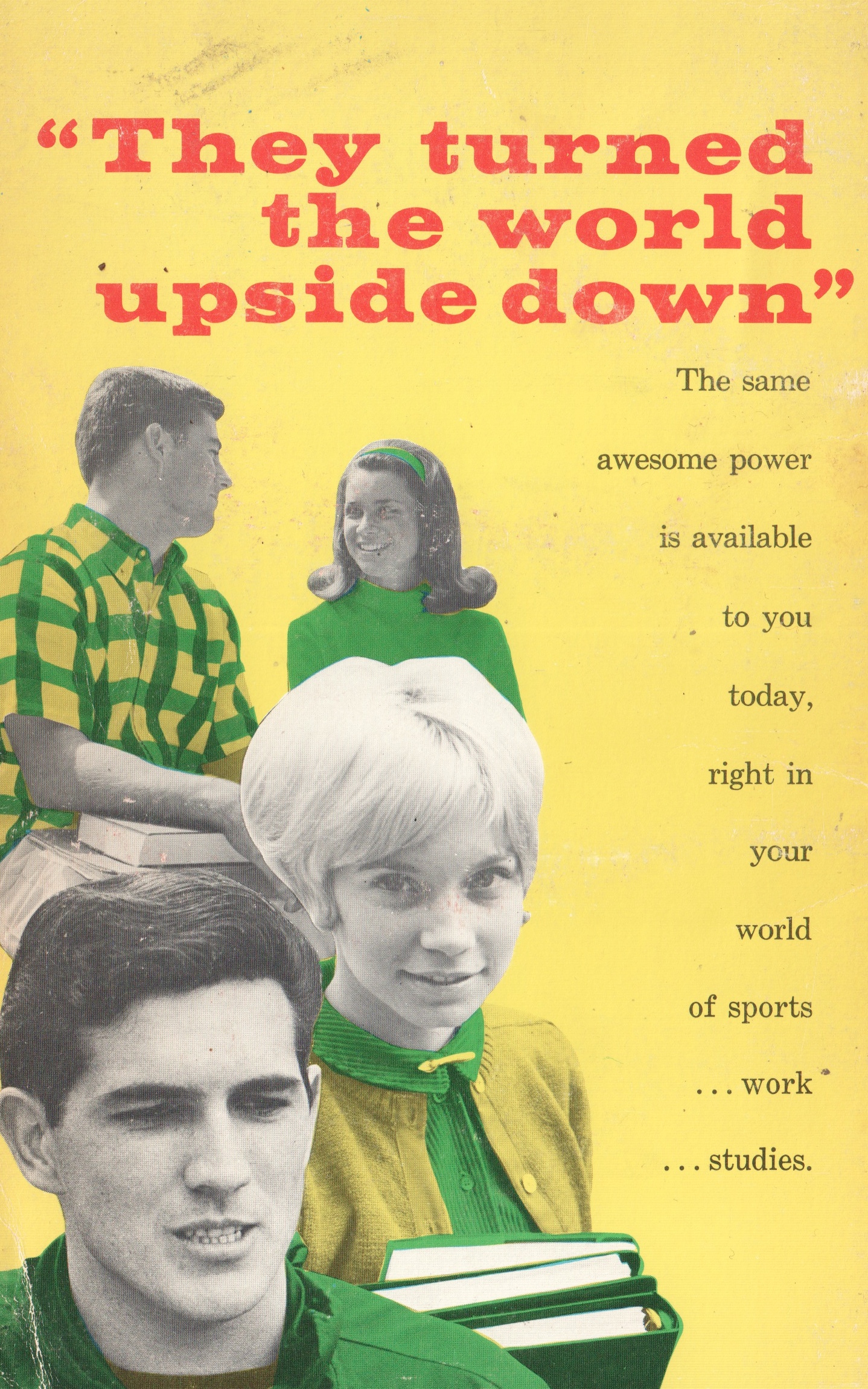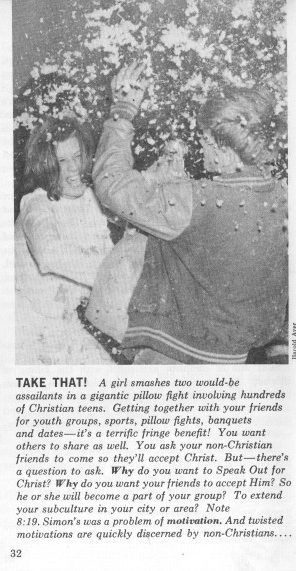The Last Twentieth Century Book Club
Speak Out!
The Last Twentieth Century Book Club, is an ongoing monthly column exploring religious ephemera by Don Jolly .
By Don Jolly
Growing up in the nineteen-nineties, it was hard not to come away with a romantic idea of the American teenager — especially the teenagers of two decades before. I was bombarded by constant, gold-tinted recreations of my parents’ youth on television, an endless montage of screaming crowds on the Ed Sullivan show fading into painted Woodstock bodies into raised fists and burning cars. Teenagers, I was told, existed in an important pop-cultural nexus: their taste, and spending power, steered the aesthetics of decades. Their political opinions, to the degree that they existed at all were worthy of consideration. . To be a teenager, I thought, was to be at the center of things, to be, at least potentially, cool.
It’s embarrassing to admit, but seeing divergent opinions on the matter still gives a kind of brain-freeze. At some fundamental level, I assume that teens have agency, that they know best, and that their generative cultural powers trump any and all arguments for good taste and moderation. Positions to the contrary tend to come off as camp.
Case in point:
Speak Out is a small booklet intended for nebulously “Christian” teens, containing a vernacular rephrasing of the Book of Acts alongside artfully chosen photographs and small reflections on the life of the American adolescent. Its goal, as stated in the introduction, is to “open the door to witnessing for us ordinary people with extra-ordinary Life within.” The interior knowledge of Christ, it argues, is comparable to many “teenage” experiences, such as “getting an ‘A’ in the roughest math course of the semester,” “standing alone on a rocky mountain peak staring at breathtaking beauty” and “hitting a hole-in-one.” However, unlike such minor victories, talking about religious belief is strictly regulated in public and often met with suspicion. “If Christ lives within you, then talking about Him should be as natural as talking about … that very special date you just had,” the text observes. “Yet Speaking Out isn’t natural!”
To address the issue, Speak Out provides the stories of the Apostles’ witnessing, in Acts, as a fit model for emulation. At the same time, in the additional photographic sections, it addresses more practical concerns, and suggests ways in which its readership can apply biblical lessons to their “world of sports, work [and] studies.” The results are often bizarre.
A concern with youth “activism” is noticeable throughout Speak Out!, although the word is unfailingly qualified by the argument that “most [teen activism] is typical games and parties.” This lack of recognition for the political agency of teens seems needlessly patronizing now, especially on the page depicting “obviously … anti-Establishment” girls. However, in the context of Speak Out’s production and intended audience, they make perfect sense.
Speak Out was produced in 1967 by Youth for Christ International, the interdenominational ministry that was largely defined by the style of its first full-time evangelist, Billy Graham. A robust Christian press was a central part of the organization, and the most visible part of that press was a regular magazine, begun in 1945. At first the periodical was known as Youth For Christ, but changes in approach and a reaction to the growing sixties counter-culture prompted a change to the less-declarative title Campus Life in 1965. According to scholar Eileen Luhr, writing in the recent essay collection American Evangelicals and the 1960s [,http://www.amazon.com/American-Evangelicals-Studies-Thought-Culture/dp/0299293645] “the magazine sought to shape a new generation that might exert great influence around the globe through youthful optimism paired with Christian devotion.” Targeting an audience of middle-class, Christian whites, Campus Life aimed to promote engagement with and responsibility for global affairs, with the caveat that all “social change derived from individual conversion.” According to an edition of the Campus Life Forum, a regular feature, in 1971:
“Campus Life asserts that we can reach for genuine heroism in a vast drama of good vs. evil which we are all (whether we know it or not) participating in. We assert that we must go beyond protesting bigotry and hypocrisy, that there is a radical Christian life-style upon which we can build— changing individuals, and therefore society itself.”
Activism was an important term within Campus Life, and the idea of specifically Christian activism generated by Christian witnessing was held up as the publication’s overarching goal. This prompted an adoption, on some level, of the trappings of non-evangelical activism in the nineteen-sixties. Luhr, for instance, cites “a 1966 article titled ‘The Tallest Placard,’” wherein author Gordon Maclean “described a masculine Jesus who supported an activist faith… a ‘real man’ who became the ‘greatest Revolutionary history has ever known!’” In other words, the “activism” which Speak Out dismisses so handily is not suspect because of the age of its participants. Rather, it is not “true” activism, as the editors of Campus Life understand it. If social change can only occur through conversion, the true activists are the readers of Speak Out. It is they who have the power to “[turn] the world upside down.”
Some photo-captions from Speak Out even make a point of allaying readers’ fears at ministering to “anti-establishment” types. In the photo of the protest above, for instance, Campus Life editor Harold Myra, author of Speak Out’s additional text, makes it a point that the student protestor’s “actions indicate a searching for the fulfillment Christ could bring.” In other sections, racial differences and fashion cues are dismissed as barriers to ministry:
This produces the booklet’s most interesting page, which arranges a reflection of Myra’s beside an ambiguous poem from Sonia Wardle and the image of a short-haired, poorly-lit young woman. “Do we sometimes confuse culture with Christianity?” it asks, from a position somewhere between sympathy and pity. The sympathy may be found in Wardle’s poem, “The Outsider, which embodies the thoughts of its irreligious protagonist so forcefully that it can be read as a credible counter-example to Speak Out’s entire ministerial enterprise. Wardle’s narrator is a “proud unreachable,” and her condition, though anguished, seems to have been assumed with such overpowering force that it earns the reader’s respect as an act of willpower. While it is tempting to assume the sympathetic reading as unintended, Myra’s commentary treads similar water, summarizing the concern that religious conversion might amount to nothing more than a transformation of style, the creation of a “carbon copy.” This, Myra argues, is missing the point. Fashion, music, cigarettes, hair-dos – these are superficial things. They are also, ironically, icons of what I identify as teenage agency. Speak Out refutes this notion by arguing for the existence of a deeper agency, founded on the same conversion which the larger Campus Life project positions as the cornerstone of social change.
On my first reading, I’ll admit I laughed my way through this material. Speak Out and Youth for Christ International are definitely not “cool” in any kind of identifiable way. But they aren’t trying to be — and that’s the trick. Speak Out, from the perspective of its authors, actually respects the political and social potential of teenagers far more than the counter-culture, which it sees as lightweight and unproductive. If social change is generated by conversion, inspiring teens to witness is inspiring them directly towards social change. Speak Out actually agrees with my implicit understanding of the “teenager” as existing in a nexus of cultural power — it just doesn’t share my pop-focused understanding of culture. That’s an interesting message, and a nuanced one. I almost missed it entirely.
That said, sixteen-year-old me wouldn’t set foot in a “gigantic pillow fight involving hundreds of Christian teens” if you paid him ten-thousand dollars.
These days I’d do it for free.






